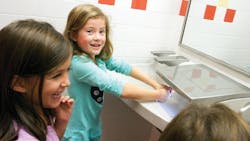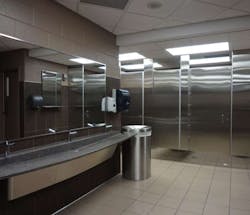Traditionally, school restrooms tend to get a bad rap. Our culture sometimes exaggerates the “ick factor” of public restrooms – a stigma these highly useful and necessary facilities must overcome. When school restrooms are not designed and maintained adequately, they can sometimes become havens for student misbehavior, vandalism attempts – and germs.
Poorly maintained restrooms also discourage students from staying in the room long enough to follow through with proper hand washing, which is a must for preventing the spread of illness in close-contact school environments. According to the Centers for Disease Control and Prevention (CDC), good hand washing practices – scrubbing for at least 20 seconds – is the best antidote to germs. The CDC says nearly 22 million school days in the United States are lost each year due to colds, and 38 million days are lost yearly to the influenza virus – both of which are transmitted through contact. A 2013 national survey about public hand washing behavior conducted by the Bradley Corporation (see sidebar) reveals that a majority of respondents skipped hand washing because of various problems in the restroom. The most common complaints: a really bad smell (cited by 82 percent); clogged/unflushed toilets (79 percent); and an overall appearance that’s dirty, unkempt or old (73 percent). And 70 percent of those surveyed admitted they have skipped using soap because no soap was available, the sink or soap dispenser was broken, or the restroom was too unclean.
Schools are not immune to these types of restroom problems. School restroom advocate Tom Keating, Ph.D., of Project CLEAN has estimated that one-third of more than 900,000 public school bathrooms in this country are dirty, unhealthy or unsafe.
The key task at hand for school administrators and facility managers is designing and maintaining attractive restroom environments that encourage a positive school image and hand washing, while discouraging vandalism and accidents. High-quality furnishings, such as lavatories, hand dryers, partitions, washroom accessories, lockers and showers – and a clean setting – can make a significant difference. New generation fixtures promote the principles of good restroom design – hygiene, safety, durability, sustainability, maintainability and operational efficiency.
The Advantages of Touch-Free Fixtures
In 2011, University of Colorado researchers examined the microbial biogeography of public restroom surfaces and found that the hand washing process was responsible for significant bacterial exposure, as soap dispensers contained even more bacteria than toilet seats.
Using sensor-operated faucets, flush valves, soap dispensers and hand dryers can help minimize touchpoints on germ-ridden restroom surfaces and reduce cross-contamination from users’ hands. Touchless fixtures improve hygiene in the restroom and the rest of the school, as users leave the restroom area and enter other parts of the building.
Touchless hand washing fixtures are also easier to keep in good working condition. “Hands-free” design helps reduce every day wear and tear, extra costs by controlling product usage with an automatic shut off, and vandalism attempts like leaving a faucet running or making a mess with soap or paper towels.
Similarly, wet floors are a major obstacle to school restroom cleanliness and safety, and require facility management’s constant attention. Each year more than 234,000 people at least 15 years old end up in emergency rooms due to washroom injuries such as slips and falls, according to a 2008 CDC study. Some newer lavatory fixtures are specifically designed to minimize water splashing on the floor, such as a completely touchless all-in-one hand washing unit that provides a sink, soap, faucet and hand dyer all in one station. This eliminates the need for users to walk from the basin with dripping wet hands in search of a towel or hand dryer.
Minimizing Paper and Water Waste
Schools and universities use an abundance of paper and water, and paper towels account for thousands of dollars in expenses annually. Today’s high-efficiency touchless hand dryers, which dry hands in 12 seconds or less, eliminate litter and vandalism attempts, and minimize staff time devoted to restocking and garbage pick-up.
As for water, commercial buildings consume 88 percent of America’s potable water, and plumbing fixtures make up 47 percent of that figure, according to a 2008 study published in an industry publication. Analyzing plumbing fixtures’ water consumption rates and looking for ways to lower the flow is a good idea from environmental and efficiency standpoints. While a water distribution audit can help with leak-detection prioritization, updating fixtures is another consideration. A standard low-flow faucet uses half a gallon of water per minute, and many educational facilities use outdated faucets that use much more. New technologies can reduce flow rates of faucets to .38 gallons per minute (GPM), which can deliver more than 24 percent in cost reductions compared to the previous generation of low-flow faucets.
ROI of High-Performance Restroom Fixtures
In the age of student health and safety concerns, cost-conscious building budgets and rising sustainability initiatives, there are many new and innovative materials and technologies to enhance the operational efficiency of school restroom environments. Students and staff also have much to gain from inviting and comfortable restroom settings, including improved hygiene, safety and overall school perception.
Haas is product manager for Bradley Corporation, Menomonee Falls, Wis., a USGBC member and manufacturer of locker room products, plumbing fixtures, washroom accessories, partitions and emergency fixtures.
About Bradley’s Survey
Bradley’s Fifth Annual Healthy Hand Washing survey queried 1,015 American adults Aug. 1-5, 2013 about their hand washing habits in workplace and public restrooms. Participants were from around the country, ranged in age from 18 to 65 and older, and were fairly evenly split between men and women (47 and 53 percent). More results are available at http://www.bradleycorp.com/handwashing.


